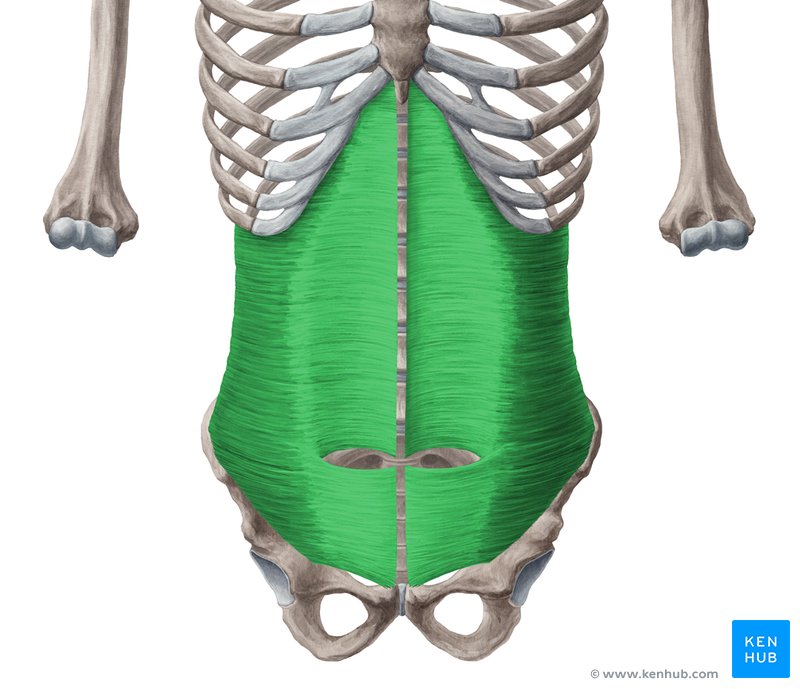Back
The Transverse Abdominis Muscle: Core Strength and Harmony with the Pelvic Floor
By Dr. Christine Martirez PT, DPT on 2/7/2024

The human body is a marvel of interconnected muscles working in harmony to support various functions. Among these intricate structures lies the transverse abdominis muscle, a core powerhouse with a crucial role in stability and coordination. In this blog post, we'll explore the function, origin, insertion, and innervation of the transverse abdominis, shedding light on how it collaborates seamlessly with the pelvic floor muscles for optimal core strength.
Unveiling the Transverse Abdominis
Function:
The transverse abdominis (TrA) is a deep abdominal muscle with a unique horizontal fiber orientation. Its primary function is to provide stability and support to the lumbar spine and pelvis. Unlike the more superficial abdominal muscles, the TrA acts like a corset, compressing the abdominal contents and enhancing core stability.Origin and Insertion:
The transverse abdominis originates from the inguinal ligament, iliac crest, and the lower six ribs. Its fibers run horizontally, wrapping around the abdomen like a belt. The muscle inserts into the linea alba, forming the midline of the abdomen, and the pubic crest.Innervation:
The TrA is innervated by the anterior rami of the lower thoracic and upper lumbar nerves (T6-L1). This intricate network of nerves allows for precise control and coordination of the muscle's actions.The Dynamic Partnership with the Pelvic Floor
Core Stability and Support:
The transverse abdominis and pelvic floor muscles work synergistically to provide a stable and supportive core. This collaboration is essential for maintaining proper alignment of the pelvis and spine, especially during activities that involve lifting, bending, or weight-bearing.Intra-Abdominal Pressure Control:
Both the TrA and pelvic floor muscles play a crucial role in managing intra-abdominal pressure. During activities like lifting heavy objects or during childbirth, these muscles work in unison to control pressure and prevent excessive strain on the pelvic organs and lower back.Pelvic Floor Engagement:
Activating the transverse abdominis often coincides with the engagement of the pelvic floor muscles. This coordination is evident in movements such as coughing, sneezing, or laughing, where both muscle groups work together to maintain continence and support the pelvic organs.Postural Support:
The transverse abdominis contributes to maintaining optimal posture by stabilizing the lumbar spine and pelvis. Its partnership with the pelvic floor muscles is crucial for preventing postural deviations that could lead to discomfort or dysfunction.
Exercises for Transverse Abdominis Activation
Transverse Abdominis Contraction:
Lie on your back with knees bent. Inhale, and as you exhale, engage the transverse abdominis by drawing your navel toward your spine. This movement helps activate the muscle and supports pelvic floor engagement.Abdominal Hollowing:
Kneel on all fours, inhale deeply, and as you exhale, draw your abdominal muscles upward and inward. Maintain normal breathing while keeping the transverse abdominis activated.Supine Leg Slides:
Lie on your back with one knee bent and the other leg extended. Slide the extended leg along the floor, engaging the transverse abdominis to stabilize the pelvis and lower back.
A Core Symphony of Strength
The transverse abdominis, with its unique structure and function, is important in the intricate web of core stability. Its collaboration with the pelvic floor muscles ensures not only the structural integrity of the core but also contributes to overall well-being and functional movement. As we engage in exercises that activate and strengthen the transverse abdominis, we pave the way for a harmonious interplay between these deep abdominal muscles and the pelvic floor—creating a symphony of strength that supports us in every step of our daily lives.
Read More:
How Chronic Pelvic Congestion in Men Contributes to Prostatitis By Shannon Strauch, PTA, STMT-1 on 12/11/2024 How lymphatic issues can cause symptoms of prostatitis Prostatitis and Tight Pelvic Floor Muscles: A Comprehensive Guide By Shannon Strauch, PTA, STMT-1 on 12/10/2024 How a tight pelvic floor can be the reason for prostatitis symptoms
Are you ready to live pain free?
Request An Appointment